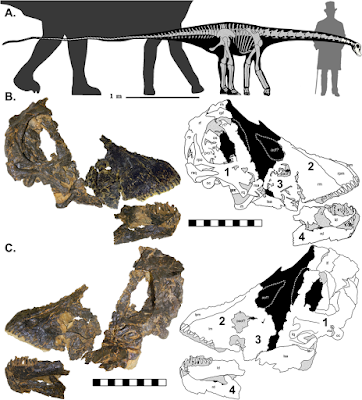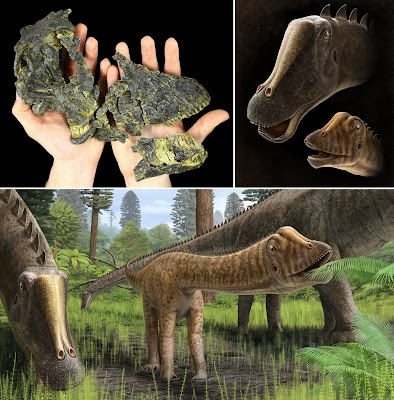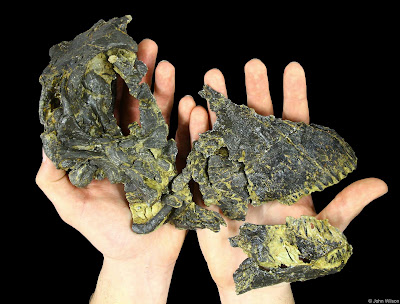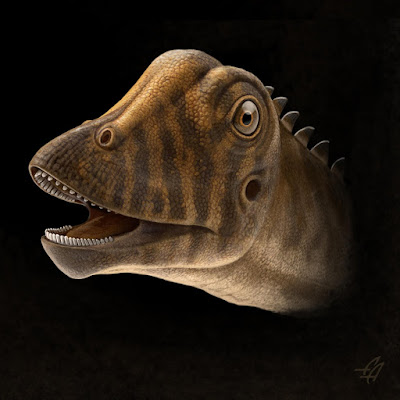|
|
| Пишет Species New to Science ( @ 2018-10-12 13:08:00 |
|
|
|
|
|
|
|
|
|
|
|
|
|
|
[Paleontology • 2018] The Smallest Diplodocid Skull Reveals Cranial Ontogeny and Growth-Related Dietary Changes in the Largest Dinosaurs
Conclusions:
Abstract
Sauropod dinosaurs were the largest terrestrial vertebrates; yet despite a robust global fossil record, the paucity of cranial remains complicates attempts to understand their paleobiology. An assemblage of small diplodocid sauropods from the Upper Jurassic Morrison Formation of Montana, USA, has produced the smallest diplodocid skull yet discovered. The ~24 cm long skull is referred to cf. Diplodocus based on the presence of several cranial and vertebral characters. This specimen enhances known features of early diplodocid ontogeny including a short snout with narrow-crowned teeth limited to the anterior portion of the jaws and more spatulate teeth posteriorly. The combination of size plus basal and derived character expression seen here further emphasizes caution when naming new taxa displaying the same, as these may be indicative of immaturity. This young diplodocid reveals that cranial modifications occurred throughout growth, providing evidence for ontogenetic dietary partitioning and recapitulation of ancestral morphologies.
 |
| Figure 1: Skeletal reconstruction of CMC VP14128 to scale with a mature Diplodocus carnegii (dark grey). Grey bones are missing, while those in ivory are those present in CMC VP14128. Skeletal reconstruction based on the Diplodocus by S. Hartman. Silhouettes by S. Hartman and PhyloPic (Creative Commons Attribution-ShareAlike 3.0 Unported; phylopic.org; creativecommons.org), modifications made. Skeletal reconstruction of CMC VP14128 redrawn from D. carnegii skeletal by S. Hartman (skeletaldrawing.com). Human scale is Andrew Carnegie at his natural height of 1.6 m. Skeletal and silhouettes to scale. (B) CMC VP14128 in right lateral view with accompanying schematic. (C) CMC VP14128 in left lateral view with accompanying schematic. Schematics by DCW. The four portions of the skull numbered on accompanying schematics. Lateral views and schematics to scale. a: angular, al: alisphenoid, aof: antorbital fenestra, d: dentary, f: frontal, h: hyoid, l: lacrimal, m: maxilla, n: nasal, oc: occipital condyle, os: orbitosphenoid, p: parietal, paof: preantorbital fenestra, pf: prefrontal, pm: premaxilla, po: postorbital, pro: prootic, q: quadrate, sa: surangular, sq: squamosal. L and r before bone denotes if it is left or right. |
Systematic Paleontology
Saurischia Seeley 1887
Sauropodomorpha von Huene 1932
Sauropoda Marsh 1878
Diplodocoidea Marsh 1884
Flagellicaudata Harris and Dodson 2004
Diplodocidae Marsh 1884
cf. Diplodocus Marsh 1878.
....
Within Dinosauria, there are small bodied taxa that display basal and derived characters and occupy unusual basal phylogenetic positions. The validity and position of such taxa has been disputed, and regarding sauropodomorph phylogeny, we would advocate that the combination of basal and derived characters and basal phylogenetic recovery should be recognized as an indicator of an immature ontogimorph – instead of a distinct taxon. In light of the current wealth of information pertaining to dinosaur ontogeny, we can no longer assume that all morphological differences correspond with phylogenetic distinctiveness. Accounting for ontogeny could prove as test for our phylogenies. Recognizing the ontogenetic age of immature specimens provides important insights into the life history of these animals. The immature Diplodocus specimen CMC VP14128 extends our understanding of the ontogeny of the genus and the evolution of diplodocids into new areas, where:
(1) The combination of basal and derived characters in the juvenile is broadly congruent with the phylogenetic transition from eusauropods to diplodocoids.
(2) The plesiomorphic tooth morphology is retained in immature Diplodocus and lost with maturity, and we predict this growth pattern will be seen in all other diplodocoids.
(3) As first proposed by Whitlock et al. (2010), tooth and skull morphology indicate that during growth Diplodocus inhabited different trophic levels/niches, where juveniles were generalists (i.e., browsers; Fig. 5) and more mature individuals were specialists (i.e., ground-level browsing), a pattern that we predict is ancestral for Diplodocoidea.
D. Cary Woodruff, Thomas D. Carr, Glenn W. Storrs, Katja Waskow, John B. Scannella, Klara K. Nordén and John P. Wilson. 2018. The Smallest Diplodocid Skull Reveals Cranial Ontogeny and Growth-Related Dietary Changes in the Largest Dinosaurs. Scientific Reports. 8, Article number: 14341. DOI: 10.1038/s41598-018-32620-x







